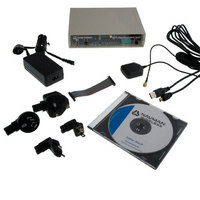AA003053-G Navman Wireless, AA003053-G Datasheet - Page 7

AA003053-G
Manufacturer Part Number
AA003053-G
Description
DEV KIT FOR JUPITER 30XLP
Manufacturer
Navman Wireless
Type
Receiver, GPSr
Specifications of AA003053-G
Frequency
1575.42MHz
For Use With/related Products
Jupiter 30XLP
Lead Free Status / RoHS Status
Lead free / RoHS Compliant
Other names
943-1000
3.0 Performance characteristics
3.1 TTFF (Time To First Fix)
TTFF is the actual time required by a GPS receiver to achieve a position solution. This
specification will vary with the operating state of the receiver, the length of time since the last
position fix, the location of the last fix, and the specific receiver design.
Aiding is a method of effectively reducing the TTFF by making every start Hot or Warm.
3.2 Acquisition times
Table 3-1 shows the corresponding TTFF times for each of the acquisition modes.
3.3 Timing 1PPS output
The 1 PPS output of the Jupiter 30 xLP receiver is < 1 µs, typical ± 300 ns ref UTC. Refer to Table
6-2 for the default status on the Jupiter 30 xLP.
3.4 Power management
The Jupiter 30 xLP offers two power saving modes: Adaptive TricklePower and Push-To-Fix,
which can be set using NMEA or SiRF Binary messages.
LA000576D © 2008 Navman Wireless OEM Solutions. All rights reserved. Proprietary information and specifications subject to change without notice.
3.1.1 Hot start
A hot start results from a software reset after a period of continuous navigation, or a return
from a short idle period (i.e. a few minutes) that was preceded by a period of continuous
navigation. In this state, all of the critical data (position, velocity, time, and satellite
ephemeris) is valid to the specified accuracy and available in SRAM. Battery backup of the
SRAM and RTC during loss of power is required to achieve a hot start.
3.1.2 Warm start
A warm start typically results from user-supplied position and time initialisation data or
continuous RTC operation with an accurate last known position available in memory. In this
state, position and time data are present and valid but ephemeris data validity has expired.
3.1.3 Cold start
A cold start acquisition results when either position or time data is unknown. Almanac
information is used to identify previously healthy satellites.
3.4.1 Adaptive TricklePower
The Jupiter 30 xLP can use the Adaptive TricklePower (ATP) feature, which reduces power
consumption by intelligently switching between full power in tough GPS environments and
low power in strong GPS signal areas.
When signal levels drop, the receiver returns to full power so that message output rates
remain constant. This results in variable power savings but much more reliable performance
for a fixed output rate. Applications using ATP should give performance very similar to full
power, but with significant power savings in strong signal conditions.
ATP is best suited for applications that require solutions at a fixed rate as well as low power
consumption and still maintain the ability to track weak signals.
With ATP at a 1 second update, a power saving of 50% can easily be achieved with minimal
degradation in navigation performance.
re-acquisition (<10 s obstruction)
Table 3-1: Acquisition times at –125 dBm
warm start TTFF
cold start TTFF
hot start TTFF
Mode
500 ms
Typ
31 s
33 s
@ –125 dBm
1 s
90%
<1 s
36 s
38 s























